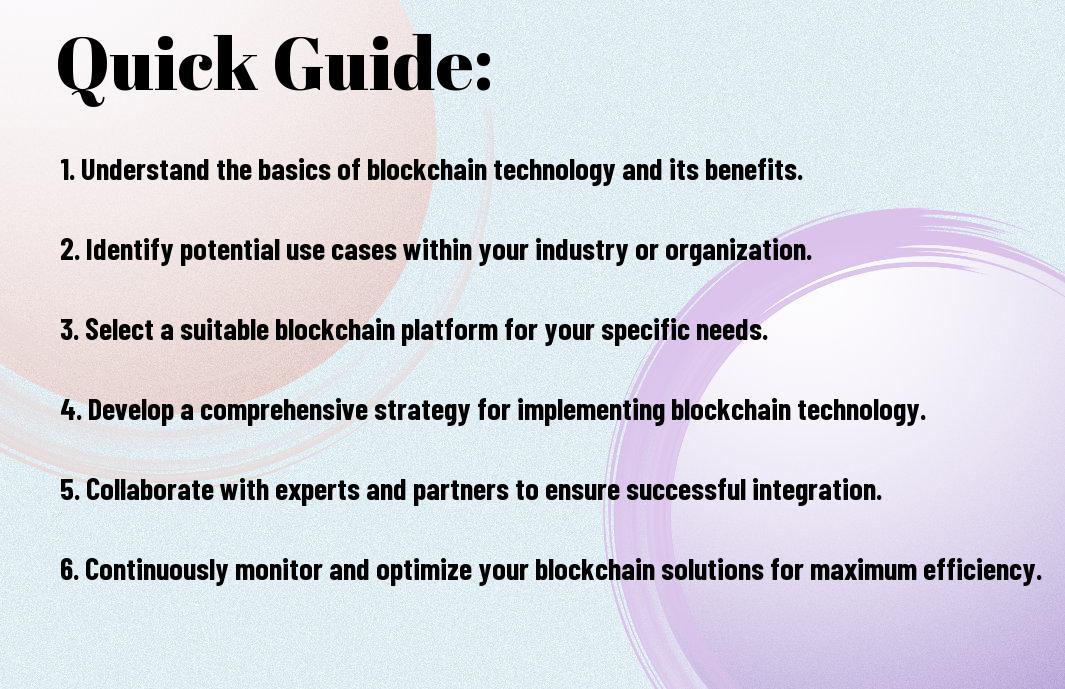You’ve heard about blockchain technology and its potential to revolutionize industries, but do you know how to harness its power effectively? In this guide, we will explore the key strategies and best practices for leveraging blockchain technology to drive growth and innovation in your business. From enhancing security and transparency to streamlining operations and reducing costs, blockchain offers a range of benefits that can transform your organization. For a deeper look into leveraging blockchain technology for growth, check out this resource.

Exploring the Different Types of Blockchain Technology
Some of the most popular types of blockchain technology include Public Blockchains, Private Blockchains, Consortium Blockchains, and Hybrid Blockchains. Each type serves different purposes and has unique features that cater to various needs and requirements. Understanding the differences between these types is crucial for leveraging blockchain effectively.
Public Blockchains
Types of blockchains, which are public, allow anyone to participate and read, write, or audit the blockchain. They are decentralized in nature, making them transparent and resistant to censorship. Public blockchains, such as Bitcoin and Ethereum, operate on a peer-to-peer network, providing security through consensus mechanisms like Proof of Work.
Private Blockchains
Private blockchains, in contrast to public ones, limit the access to write permissions to a single organization. These are ideal for businesses that require privacy and control over their data. Security features can be customized as per the organization’s needs, making private blockchains suitable for internal use cases where trust is established among participants.
Consortium Blockchains
Blockchains, shared among a group of organizations or companies, fall into the category of consortium blockchains. These semi-decentralized networks offer a balance between the openness of public blockchains and the control of private ones. Consortium blockchains are governed by a group of pre-selected nodes, ensuring efficiency and scalability without compromising security.
Hybrid Blockchains
With features of both public and private blockchains, hybrid blockchains provide a flexible solution for various use cases. They offer the benefits of transparency and decentralization along with control over permissions. Hybrid blockchains are suitable for industries that require a blend of security and openness while maintaining certain levels of confidentiality.
This exploration into the different types of blockchain technology showcases the versatility and adaptability of this revolutionary technology. Whether you opt for a public, private, consortium, or hybrid blockchain, understanding the unique characteristics of each type is important for effectively leveraging blockchain technology in your projects.
Step-by-Step Guide to Implementing Blockchain
| Identifying Use Cases for Your Business | Choosing the Right Blockchain Type |
Identifying Use Cases for Your Business
You may be wondering how to leverage blockchain technology effectively for your business. The key is to identify the right use cases that can benefit from blockchain’s decentralized and secure nature. Look for processes that involve multiple parties, require transparency and traceability, or involve high-value assets that need protection.
Choosing the Right Blockchain Type
Guide your decision-making process by choosing the right type of blockchain for your specific use case. Depending on your requirements, you can opt for public blockchains like Ethereum for open and permissionless networks, private blockchains for controlled access and permissions, or consortium blockchains for specific industries or business collaborations.
Developing a Proof of Concept
Any successful blockchain implementation starts with developing a proof of concept (PoC) to validate the feasibility and benefits of your solution. This involves creating a small-scale version of your blockchain application to test its functionality, scalability, and performance before investing resources in full-scale development.
Scaling Your Blockchain Solution
Scaling your blockchain solution is imperative to accommodate growth and increased transactions on the network. As your business expands, you’ll need to consider factors like network capacity, transaction speed, and consensus mechanisms to ensure seamless operations and efficient performance.
Handy Tips for Effective Blockchain Utilization
Keep your blockchain implementation on the right track with these handy tips:
- Ensure data quality and security at all times
- Foster user adoption and provide adequate training
- Navigate regulatory compliance effectively
- Partner with trusted blockchain providers for success
Ensuring Data Quality and Security
Security is paramount when it comes to blockchain technology. Implement robust encryption methods, access controls, and regular audits to safeguard your data and ensure its integrity. Trustworthy data is the cornerstone of any successful blockchain implementation.
Fostering User Adoption and Training
Blockchain technology can be complex for users unfamiliar with it. To boost adoption rates, provide comprehensive training sessions and user-friendly interfaces. Educate users on the benefits of blockchain technology and how to navigate the platform effectively to ensure a smooth transition.
Navigating Regulatory Compliance
Adoption of blockchain technology involves adherence to various regulations and compliance standards. It is vital to stay informed about the legal requirements in your industry and work closely with legal experts to ensure compliance. Handy tips can help you navigate the complex regulatory landscape successfully.
Partnering with Trusted Blockchain Providers
There’s no substitute for experience and expertise when it comes to blockchain. Partnering with trusted blockchain providers can offer you the necessary guidance and support to implement and maintain your blockchain network effectively. These experts can help you avoid common pitfalls and maximize the benefits of blockchain technology for your organization.
Evaluating Blockchain Technology: Factors to Consider
To effectively leverage Blockchain Technology, it is crucial to evaluate various factors before implementation. Assessing the pros and cons, conducting a cost-benefit analysis, and understanding the long-term implications are imperative steps in this process.
Assessing the Pros and Cons of Blockchain Adoption
When considering the adoption of Blockchain Technology, it’s important to weigh the advantages and disadvantages. Below is a breakdown of the pros and cons:
| Pros | Cons |
| Increased transparency | High energy consumption |
| Enhanced security | Scalability challenges |
| Reduced costs | Regulatory uncertainty |
Cost-Benefit Analysis
Evaluating the cost-benefit of implementing Blockchain Technology is crucial. Organizations need to consider both the initial investment and potential long-term savings. It is imperative to ensure that the benefits outweigh the costs to justify adoption.
Blockchain technology offers numerous advantages that can improve processes, enhance security, and reduce costs. However, organizations must also consider the implementation and maintenance costs, regulatory compliance, and scalability issues.
Understanding the Long-term Implications
Considering the long-term implications of Blockchain Technology is vital for successful integration. Organizations need to anticipate how blockchain may impact their operations, regulatory compliance, and overall business strategy. It’s crucial to stay informed about industry developments and continuously assess the technology’s impact.
The Dos and Don’ts of Blockchain Implementation
Best Practices for Success
All successful blockchain implementations start with a clear understanding of the problem you are trying to solve. Assuming you have identified the use case, it is imperative to collaborate with all stakeholders to ensure alignment on goals and expectations. Additionally, choosing the right blockchain platform that suits your specific needs and ensuring proper encryption and security measures are in place are crucial for a successful implementation.
Common Pitfalls to Avoid
Now, when it comes to implementing blockchain technology, there are some common pitfalls to avoid. For instance, one of the most critical mistakes is not conducting thorough research and due diligence before selecting a blockchain platform. Choosing the wrong platform can lead to inefficiencies, security vulnerabilities, and even project failure. Moreover, neglecting to train your team adequately on how to use and maintain the blockchain technology can also lead to setbacks.

Final Words
Drawing together the various ways to leverage blockchain technology effectively, it is clear that businesses can greatly benefit from its transparency, security, and efficiency. By integrating blockchain into their operations, organizations can streamline processes, enhance trust among stakeholders, and ensure the integrity of data. Through smart contracts, decentralized applications, and supply chain management, blockchain offers numerous opportunities for innovation and growth. With the right strategy and implementation, businesses can harness the power of blockchain technology to stay competitive in today’s digital landscape. Embracing this powerful tool can pave the way for a more secure, transparent, and decentralized future.
FAQ
Q: What is Blockchain Technology?
A: Blockchain technology is a decentralized, distributed ledger that securely records transactions across a network of computers. Each transaction is stored in a block, linked to previous transactions, creating a chain of blocks hence the name “blockchain”.
Q: How can businesses leverage Blockchain Technology effectively?
A: Businesses can leverage Blockchain Technology effectively by implementing it for secure and transparent transactions, improving supply chain management, enhancing cybersecurity, enabling smart contracts, and creating decentralized applications (dApps).
Q: What are the key benefits of leveraging Blockchain Technology?
A: The key benefits of leveraging Blockchain Technology include increased security through encryption and decentralization, improved transparency and traceability of transactions, reduced costs by eliminating intermediaries, faster and more efficient transactions, and enhanced trust among all parties involved.
